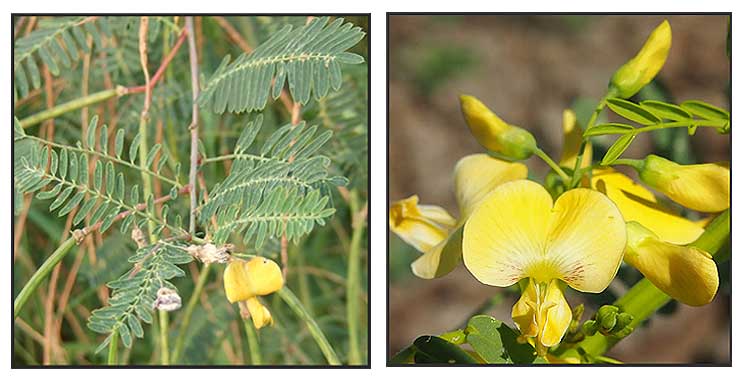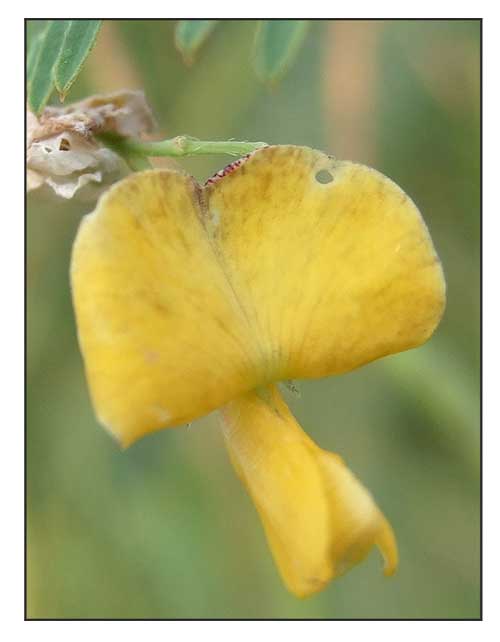 Gen info Gen info
- Sesbania is a genus of flowering plants in the pea family, Fabaceae, and the only genus in the tribe Sesbanieae. Species are often referred to as river hemp. About 60 species are currently accepted; about 39 are still unresolved.
Botany
• Yellow Pea Bush is an erect, annual legume, somewhat woody, up to about 3.5 m high, stems with spreading hairs when young, more or less hairless later, round or slightly angular. Leaves are compound, with 12-30 pairs of leaflets. Leaflets are narrowly-oblong, tip blunt or flat-apiculate, 7-8 x 1.5-3 mm hairless or with a few appressed hairs. Flowers are borne in a raceme of one to three (five) flowers. Flower-stalks are more or less equal to the calyx. Calyx 3-4 mm long, sepals up to about half as long as the tube. Flowers are yellow, standard prominently streaked on the back, 0.8-1.1 cm long. Pods are slender, 12-20 cm long, 2.5-3 mm, with a slender tip. Seeds are dark brown, about 4 mm long. (Flowers of India)
 • Herbs, annual, 3-3.5 m tall. Stems green or sometimes brown, smooth, with inconspicuous light greenish stripes, slightly glaucous, basally with many adventitious roots; young branches sparsely appressed villous, glabrescent, with white mucilage when broken. Stipules lanceolate, caducous. Leaves 40-60(-80)-foliolate; rachis 15-25 cm, sparsely appressed villous when young, glabrescent, adaxially grooved; petiolules ca. 1 mm, with sparsely appressed trichomes; stipels subulate, subequal to petiolules or shorter, persistent; leaflet blades opposite or subopposite, linear-oblong, 8-20(-40) × 2.5-4(-7) mm, smaller at both ends of rachis than in middle, both surfaces with appressed purplish glands but abaxially denser, abaxially sparsely appressed villous when young but glabrescent, adaxially glabrous, both ends asymmetric, base rounded, apex blunt to truncate and mucronate. Racemes 3-10 cm, 2-6-flowered, lax; peduncle slender, pendulous, sparsely appressed villous; bract linear-lanceolate, caducous. Pedicel slender, pendulous, sparsely appressed villous; bracteoles 2, caducous. Calyx obliquely campanulate, 3-4 mm, glabrous; teeth triangular, with 1-3 appendages between each, inner margin white slender pilose, apex acute. Corolla yellow; standard lamina transversely ovate to suborbicular, 9-10 mm, with a ca. 2 mm claw, base subrounded and with a small pyriform callus, apex retuse to rounded; wings obovate-oblong, ± as long as standard, ca. 3.5 mm wide, with transverse corrugation, base shortly auriculate, middle with dark grayish brown spots; keel broadly triangular-ovate, shorter than wings, as long as wide, with a ca. 4.5 mm claw, apex obtuse. Anthers ovate to oblong. Pistil glabrous; stigma capitate. Legume long terete, slightly curved, 12-22 cm × 2.5-3.5 mm, dehiscent, outside with dark brown stripes, trabeculate between seeds, carpopodium ca. 5 mm, apex acute and with a 5-7(-10) mm beak. Seeds 20-35 per legume, greenish brown, terete, ca. 4 × 2-3 mm, glossy; hilum rounded, slightly oblique to one end. (Flora of China) • Herbs, annual, 3-3.5 m tall. Stems green or sometimes brown, smooth, with inconspicuous light greenish stripes, slightly glaucous, basally with many adventitious roots; young branches sparsely appressed villous, glabrescent, with white mucilage when broken. Stipules lanceolate, caducous. Leaves 40-60(-80)-foliolate; rachis 15-25 cm, sparsely appressed villous when young, glabrescent, adaxially grooved; petiolules ca. 1 mm, with sparsely appressed trichomes; stipels subulate, subequal to petiolules or shorter, persistent; leaflet blades opposite or subopposite, linear-oblong, 8-20(-40) × 2.5-4(-7) mm, smaller at both ends of rachis than in middle, both surfaces with appressed purplish glands but abaxially denser, abaxially sparsely appressed villous when young but glabrescent, adaxially glabrous, both ends asymmetric, base rounded, apex blunt to truncate and mucronate. Racemes 3-10 cm, 2-6-flowered, lax; peduncle slender, pendulous, sparsely appressed villous; bract linear-lanceolate, caducous. Pedicel slender, pendulous, sparsely appressed villous; bracteoles 2, caducous. Calyx obliquely campanulate, 3-4 mm, glabrous; teeth triangular, with 1-3 appendages between each, inner margin white slender pilose, apex acute. Corolla yellow; standard lamina transversely ovate to suborbicular, 9-10 mm, with a ca. 2 mm claw, base subrounded and with a small pyriform callus, apex retuse to rounded; wings obovate-oblong, ± as long as standard, ca. 3.5 mm wide, with transverse corrugation, base shortly auriculate, middle with dark grayish brown spots; keel broadly triangular-ovate, shorter than wings, as long as wide, with a ca. 4.5 mm claw, apex obtuse. Anthers ovate to oblong. Pistil glabrous; stigma capitate. Legume long terete, slightly curved, 12-22 cm × 2.5-3.5 mm, dehiscent, outside with dark brown stripes, trabeculate between seeds, carpopodium ca. 5 mm, apex acute and with a 5-7(-10) mm beak. Seeds 20-35 per legume, greenish brown, terete, ca. 4 × 2-3 mm, glossy; hilum rounded, slightly oblique to one end. (Flora of China)
Distribution
- Native to the Philippines. (1) Introduced. (2)
-
In Leyte; Luzon: Batangase, Laguna, NCR, Pampanga, Rizal; MINDANAO: Agusan del Norte, Davao, Davao del Sur,Maguindanao del Sur.
- In lowlands to medium elevation along streams, open wetlands, etc. (1)
- Also native to Bangladesh, India, Myanmar, Nepal, New South Wales, Northern Territory, Queensland, South Australia, Victoria, Vietnam. (2)
 Constituents Constituents
- In a comparative study of 3 Sesbania species for chlorophyll content of leaves, Sesbania cannabina revealed highest chlorophyll a and b, and carotenoid content: 3.2 mg/g fresh weight, 2.76 mg/g FW, and 1.44 mg/g FW, in summer seasons. (6)
- Phytochemical screening of aqueous, methanol, and acetonitrile leaf extracts revealed the presence of alkaloids, flavonoids, glycosides, saponins, saponin glycoside, steroids, tannins, and volatile oils in one, two, or all three extracts.
(7)
- In a comparative study of three Sesbania species (S. cannabina, S. grandiflora, S. bispinosa) for protein content of leaves, wood, and bark, S. cannabina showed higher levels (range 3.957 to 5.939 mg/g DW). The leaves showed high level of amino acid content (range 1.034 to 1.223 mg/g dw). (8)
- Qualitative analysis of different solvent extracts of leaves revealed carbohydrates, proteins,
amino acids, tannins, glycosides, alkaloids, triterpenes, and flavonoids. (17)
Properties
- Studies have suggested antioxidant, anticancer, antioxidative, intestinal microbiota-regulating, neuroprotective, hepatoprotective properties.
Parts used
Leaves, seeds.
 Uses Uses
Edibility
- Flowers and young leaves are edible; often used as vegetable to supplement meals. Tender pods are eaten as string beans. Dried leaves used for making herbal tea for its medicinal properties. (6)
Folkloric
- No reported folkloric medicinal use in the Philippines. (2)
- Seeds and flour from S. cannabina are combined to treat wounds, ringworm, and other skin conditions. Leaves used for treatment of various ailments, including stomatitis, fever, headache, diarrhea, eye infections, oral lesions, and sore throats. Leaves are chewed for purpose of cleansing the mouth and throat. As herbal tea, dried leaves has shown anti-tumor, antimicrobial, anthelmintic, and contraceptive properties. Also used for facilitating bowel movements, increasing urine production, stimulating menstruation, promoting laxation, and enhancing general health. (5)
Others
- Agrofrestry: Plant is grown as green manure for crops such as cotton, rice, and sugar cane. It is used as cover crop and windbreak in plantations of cocoa, mango, etc. (4) A multipurpose plant, it can serve as green manure, green leaf manure, biofertilizer, and as good companion crop for wetland rice cultivation. (15)
- Fiber: The inner bark is a source of good quality of fiber; sometimes used as a substitute for jute (Corchorus species) and hemp (Cannabis sativa). (4)
- Gum: The seed is a source of galactomannan gum. (4)
- Paper: Stems are a source of pulp for making paper. (4)
- Fuel: A source of fuelwood. (4)
- Fodder: Used as fodder for livestock.
- Plastic composite potential: (See study below) (16)
Studies
• Acute Toxicity Study / Leaves: Study evaluated in-vivo toxicological effects of aqueous, methanol, and acetonitrile leaf extracts of Sesbania cannabina on Wistar albino rats. Results showed LD50 of all extracts were above 3,000 mg/kbw. The results justified its edibility. (see constituents above) (7)
• Anticancer / Galactomannan from Seeds: Study of S. cannabina seeds obtained a native galactomannan (GalM65) and a serious of hydrolysates (GalM40, -50 and -60). MTT assay showed four fractions had significant inhibitory effect on A549, Hela, HepG2, and MCF-7 in a dose-dependent manner, and GalM40 with second highest Mw (1.47x104Da) possessed higher activity among the four fractions. The strong inhibitory effect on growth of cancer cells might derive from its ability to increase caspase-12 expressions. (8)
• Seed Oil Potential for Engineering Applications: Study reported on the extraction and charac-terization of S. cannabina seed oil (SCSO) for potential engineering applications. Analysis of fatty acid composition of extracted oil showed high iodine value (118 gI2/100g) and high saponification value (185.79 mg KOH/g) making the oil suitable for use as candle stocks or in soap making, but ruled out because of limited quantity of oil. The SCSO showed high viscosity index (174.19), high onset (382°C) and offset (450°C) decomposition temperatures, endothermic nature, and shear rate thickening behavior. The properties suggest potential for the SCSO as specialty lubricant or as insulating and cooling transformer oil. (9)
• Antioxidative / No Effect on Macrophage Immune Function / Galactomannan: Study isolated a new galactomannan (GM) from S. cannabina seed. The GM was modified to obtain seleno-galacto-mannan (SeGMs). The SeGMs showed strong protective effect against H2O2-induced oxidative damage. The SeGMs showed no obvious effect on immunomodulatory activity of GM, as determined by index of TNF-α, IL-6, and IL-1ß. Study suggest potential of SeGMs from galactomannan as a dietary supplement of Se or an organic antioxidant. (11)
• Antidiabetic / Regulation of Intestinal Microbiota Effect / Galactomannan: Study evaluated the antidiabetic activity of galactomannan (SP) extracted from endoperm splits of seeds and its effects on the regulation of intestinal microbiota in streptozotocin (STZ)-induced diabetic mice. Results showed significant decrease in blood glucose and lipids of T2D mice. SP increase insulin sensitivity and improved intestinal microbiota composition of diabetic mice by high throughput deep sequencing. The effect on microbiota plays a vital role in reducing insulin resistance and blood glucose. Results suggest potential for SP as functional food for reducing blood glucose and applications in the food and pharma-
ceutical industries. (12)
• Neuroprotective / Galactomannan: Low-molecular-weight-galactomannan (LMW-GM) is an edible polysaccharide with biologic activities. Study obtained two types of LMW-GMs: GA-LMW-GM by gluconic extraction and GMOS by enzymatic hydrolysis. Antioxidant and neuroprotective testing of the LMW-GMs showed both GA-LMW-GM and GMOS possess good free radical scavenging for DPPH radicals and O2-radicals. GA-LMW-GM was more effective at scavenging reactive oxygen species (ROS) in vivo and protecting fundamental growth and locomotor functions of zebrafish with neurological damage induced by Bisphenol AF. (13)
• Neuroprotective / Galactomannan: Hemicellulosic polysaccharides of galactomannan in different biomass and their degradation products are gaining attention for their excellent antioxidant enhancement and immunomodulatory activity. Study obtained incomplete degradation products of galactomannan (IDPG) by enzymatic hydrolysis of seeds. Using an H2O2-injured RAW264.7 cells model, IDPG exhibited antioxidant capacity as indicated by SOD activity and MDA content. IDPG can improve antioxidant capacity by increasing antioxidant contents and reducing MDA content. IDPG can increase immunoglobulins and cytokines secretion, enhancing the immunity of laying hens. In vivo, IDPG significantly increased secretion of NO, TNF-α, IL-6, and toll-like receptor 4 (TLR4) in RAW264.7 cells. Overall, IDPG can improve antioxidant function and modulate immunological response. (14)
• Agricultural Plastic Composite: Study evaluated the use of dhaincha (Sesbania cannabina) and jute (Corchorus olitorius) for Agricultural Plastic Composites (APC). Coarse and fine boards made from jute and dhaincha showed satisfactory physical and mechanical properties. Results suggest the APC from dhaincha and jute sticks have potential as alternative raw materials for the manufacture of plastic composites. (16)
• Hepatoprotective / Carbon Tetrachloride Toxicity / Seeds: Study evaluated the hepatoprotective effect of S. cannabina seed extract in Wistar albino rats with carbon tetrachloride (CCL4)-induced liver injury. Results showed the seed extract significantly restored liver enzyme levels, improved antioxidant defenses, and preserved liver histology in a dose-dependent manner, comparable to standard hepato-protective agent silymarin. (18)
Availability
- Wild-crafted.
- Seeds in the cybermarket.
|

![]()



 Gen info
Gen info
 Constituents
Constituents
